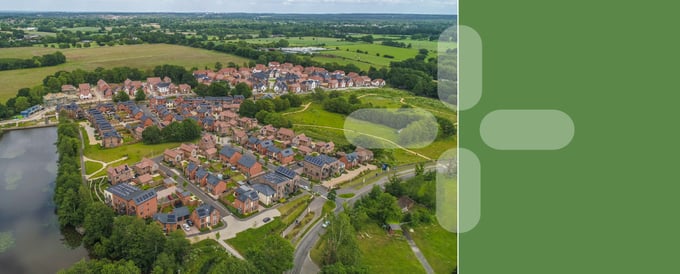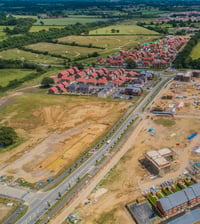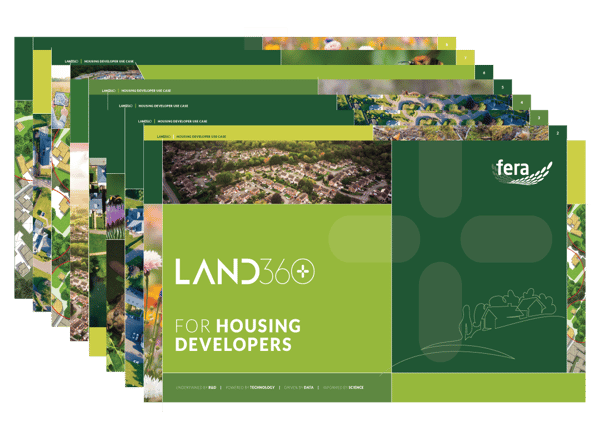For UK housing developers, making a long-term commitment to delivering biodiversity net gain (BNG) has become a regulatory necessity.
To ensure compliance with new legislation, which launched 12 February 2024, developers must provide an extensive BNG strategy for each site to gain planning permission.
This must set out different ways in which biodiversity levels will be enhanced by at least 10% over 30 years.
Working closely with an scientist, including ecologist, economists, and remote sensing experts can help developers create a bespoke biodiversity gain plan for each site, that can be feasibly implemented using a range of habitat creation strategies.
This blog details the key strategies developers could consider including within a site-specific biodiversity net gain plan to not only meet, but exceed, mandatory BNG requirements for a minimum of 30 years.
Although there is the option to create biodiversity units off-site if needed, this list provides examples of ways in which habitats can be created on-site.

Considerations for housing developers to improve on-site biodiversity
Planting trees to achieve long term BNG
Planting trees on new housing developments is considered an effective way to enhance biodiversity. The integration of trees into an area contributes significantly to carbon sequestration, addressing climate change at a local level.
Here are some ways to make the most of tree planting:
- Select a diverse range of native trees - these species are adapted to the local climate and soil conditions, offering a better survival rate throughout the 30-year period and requiring less maintenance. Plant fruit and nut trees – they provide food sources for wildlife. This diversity ensures a resilient ecosystem capable of supporting various bird, insect and mammal species.
Shrubbery and hedgerows to promote biodiversity
The strategic use of hedgerows and shrubbery can transform a development site into a thriving ecosystem.
Hedgerows, especially those composed of native shrubs and trees, create natural boundaries that offer safe passages for wildlife, such as hedgehogs, and nesting sites for birds while supporting a whole host of insects and small mammals.
These ‘green corridors’ connect different habitats, which is especially important in urban environments where natural habitats can be fragmented.
For housebuilders, this approach not only improves biodiversity but also adds aesthetic value to new developments, privacy and reduces noise pollution. Dense hedges can absorb and deflect sound more efficiently than fences, which is particularly beneficial if traffic noise is an issue.
It’s worth factoring into a site BNG plan that hedgerows require annual trimming to encourage dense growth, which is better for wildlife to thrive and maintain enhanced biodiversity levels.
Ponds and water features
Introducing an aquatic habitat to a new housing development is vital for amphibians, such as frogs and newts, to thrive and can further increase the biodiversity of certain species of birds and insects.
Ponds also provide essential drinking and bathing spots for bird and mammals, while the aquatic plants offer nectar sources for pollinators.
Water features, when designed with natural processes in mind, can be self-sustaining and require relatively low maintenance. This ensures that they continue to provide ecological benefits over the long term without requiring significant ongoing input.
Supporting BNG by rewilding
Rewilding areas within a development can also have various long-term benefits.
Identifying sections of the development site that are less suitable for construction, such as marginal lands, buffer zones, or existing green spaces, can be designated for rewilding, allowing them to naturally evolve into diverse ecosystems that contribute significantly to biodiversity net gain.
This might involve holding back on regular landscaping activities like mowing, fertilising, or planting non-native species, to create conditions where native plants and wildlife can flourish independently.
Wildflower meadows also offer a visually appealing aspect to the development. These meadows require specific management techniques, such as selective weeding and seed collection, to ensure their longevity and ecological value.
Monitoring BNG long term
Ultimately housing developers will be penalised if they do not achieve the minimum requirement of 10% BNG by the 30-year mark.
To meet and maintain the mandatory net gain results forecasted in the BNG plan submitted to planning authorities, accurate reporting with robust data is crucial.
It’s highly recommended that planners work with scientists who have the right skills and tools to ensure thorough habitat data collection, and the expertise to interpret these numbers into clear benchmarks and actionable recommendations if needed.
Enhance your new development with LAND360
Embracing BNG is not just about fulfilling a regulatory requirement; it's about creating living spaces that are in harmony with nature. By implementing on-site habitat creation strategies such as these, housing developers can play a crucial role in building biodiversity-rich, sustainable communities.
Partner with professionals who specialise in creating, managing, and assessing BNG strategies to ensure that your developments meet the BNG requirements. For more information on measuring the impact of these changes, visit here: www.fera.co.uk/land360-housing-developers
More about LAND360
LAND360 is Fera's cutting-edge natural capital assessment service. Launched in 2022, it empowers farmers, landowners, estate managers, and housing developers to make informed land use decisions. By accurately measuring and mapping existing land habitat features and modelling biodiversity offerings, LAND360 is a vital tool in the quest for sustainable development and biodiversity enhancement.
